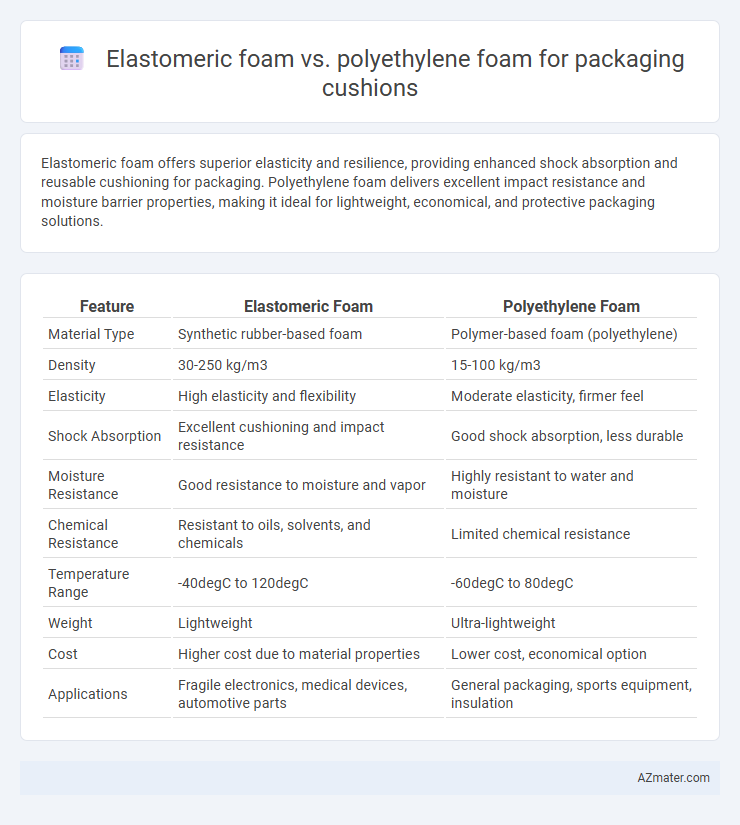Elastomeric foam offers superior elasticity and resilience, providing enhanced shock absorption and reusable cushioning for packaging. Polyethylene foam delivers excellent impact resistance and moisture barrier properties, making it ideal for lightweight, economical, and protective packaging solutions.
Table of Comparison
| Feature | Elastomeric Foam | Polyethylene Foam |
|---|---|---|
| Material Type | Synthetic rubber-based foam | Polymer-based foam (polyethylene) |
| Density | 30-250 kg/m3 | 15-100 kg/m3 |
| Elasticity | High elasticity and flexibility | Moderate elasticity, firmer feel |
| Shock Absorption | Excellent cushioning and impact resistance | Good shock absorption, less durable |
| Moisture Resistance | Good resistance to moisture and vapor | Highly resistant to water and moisture |
| Chemical Resistance | Resistant to oils, solvents, and chemicals | Limited chemical resistance |
| Temperature Range | -40degC to 120degC | -60degC to 80degC |
| Weight | Lightweight | Ultra-lightweight |
| Cost | Higher cost due to material properties | Lower cost, economical option |
| Applications | Fragile electronics, medical devices, automotive parts | General packaging, sports equipment, insulation |
Introduction to Packaging Cushioning Materials
Elastomeric foam provides superior flexibility and resilience, making it ideal for packaging fragile items requiring shock absorption and repeated compression recovery. Polyethylene foam offers excellent moisture resistance and lightweight cushioning, commonly used for protective packaging in electronic and automotive industries. Both materials enhance packaging safety, with elastomeric foam excelling in dynamic impact protection and polyethylene foam providing durable, cost-effective void filling.
Overview of Elastomeric Foam
Elastomeric foam, characterized by its flexible, resilient structure and closed-cell composition, offers superior cushioning and shock absorption compared to polyethylene foam, making it ideal for delicate packaging applications. Its excellent resistance to compression set and high durability ensure long-term protection of sensitive items during transit. Commonly used in electronics and medical device packaging, elastomeric foam provides enhanced impact resistance while maintaining lightweight properties for efficient shipping.
Overview of Polyethylene Foam
Polyethylene foam is a lightweight, closed-cell material known for its excellent shock absorption and moisture resistance, making it ideal for packaging cushioning applications. Its high tensile strength and flexibility provide superior protection for fragile items during transportation and storage. Compared to elastomeric foam, polyethylene foam offers enhanced durability, chemical resistance, and cost-effectiveness for various industrial and consumer packaging needs.
Key Physical Properties Comparison
Elastomeric foam offers superior flexibility and resilience with a typical compression set under 10%, making it ideal for repeated impact absorption in packaging cushion applications. Polyethylene foam provides higher density options ranging from 1 to 6 lb/ft3, delivering excellent rigidity and moisture resistance but less elasticity compared to elastomeric foam. The thermal conductivity of elastomeric foam ranges around 0.034 W/m*K, enhancing insulation, whereas polyethylene foam varies from 0.03 to 0.04 W/m*K, supporting temperature-sensitive packaging stability.
Impact Absorption and Shock Resistance
Elastomeric foam excels in impact absorption due to its open-cell structure, allowing superior energy dissipation and shock resistance in packaging applications. Polyethylene foam offers high resilience and closed-cell durability but typically provides less effective cushioning against high-impact forces compared to elastomeric variants. Selecting elastomeric foam enhances protection for delicate items by minimizing impact transmission, while polyethylene foam suits applications requiring moisture resistance and structural integrity.
Moisture Resistance and Environmental Durability
Elastomeric foam offers superior moisture resistance compared to polyethylene foam due to its closed-cell structure, preventing water absorption and maintaining cushioning properties in humid environments. Its enhanced environmental durability allows it to withstand temperature fluctuations and UV exposure better than polyethylene foam, which can degrade and lose protective qualities over time. Elastomeric foam's resilience and long-term performance make it an ideal choice for packaging applications requiring reliable protection against moisture and environmental stressors.
Cost Effectiveness and Economic Considerations
Elastomeric foam offers superior cushioning and durability but generally comes at a higher price point compared to polyethylene foam, making it less cost-effective for large-scale packaging applications. Polyethylene foam provides a more economical solution with adequate shock absorption and lightweight properties, resulting in lower shipping and material costs. Businesses prioritize polyethylene foam when balancing budget constraints and basic protection needs, while elastomeric foam suits high-value or fragile products requiring enhanced impact resistance.
Common Applications in Packaging
Elastomeric foam is widely used in packaging for its superior shock absorption and flexibility, making it ideal for cushioning delicate electronics, medical devices, and automotive parts during transport. Polyethylene foam offers excellent durability and moisture resistance, commonly applied in packaging for heavy equipment, food products, and consumer goods requiring impact protection and insulation. Both foams provide lightweight cushioning solutions, but elastomeric foam excels in dynamic environments, while polyethylene foam is preferred for static padding and barrier protection.
Sustainability and Environmental Impact
Elastomeric foam offers enhanced sustainability due to its recyclability and lower environmental footprint compared to conventional polyethylene foam, which is often derived from non-renewable petroleum resources and less biodegradable. The closed-cell structure of elastomeric foam improves durability and reduces material waste in packaging applications, contributing to increased product protection with fewer resources. Polyethylene foam, while lightweight and cushioning, presents challenges in end-of-life disposal, leading to higher environmental impact through landfill accumulation and limited recycling infrastructure.
Choosing the Right Foam for Packaging Needs
Elastomeric foam offers superior compression set resistance and flexibility, making it ideal for delicate or irregular-shaped items requiring high impact absorption. Polyethylene foam is denser and more rigid, providing excellent cushioning for heavy or sharp objects with better chemical resistance and moisture barrier properties. Selecting the right foam depends on the specific packaging requirements such as weight capacity, environmental exposure, and the level of protection needed during shipping and handling.

Infographic: Elastomeric foam vs Polyethylene foam for Packaging cushion
 azmater.com
azmater.com